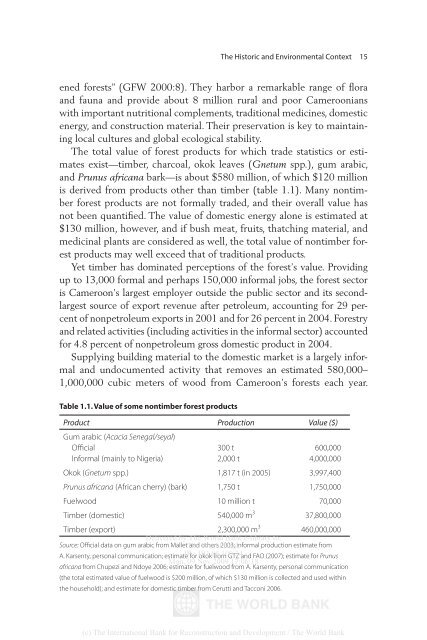The Rainforests of Cameroon - PROFOR
The Rainforests of Cameroon - PROFOR
The Rainforests of Cameroon - PROFOR
- No tags were found...
Create successful ePaper yourself
Turn your PDF publications into a flip-book with our unique Google optimized e-Paper software.
<strong>The</strong> Historic and Environmental Context 15ened forests” (GFW 2000:8). <strong>The</strong>y harbor a remarkable range <strong>of</strong> floraand fauna and provide about 8 million rural and poor <strong>Cameroon</strong>ianswith important nutritional complements, traditional medicines, domesticenergy, and construction material. <strong>The</strong>ir preservation is key to maintaininglocal cultures and global ecological stability.<strong>The</strong> total value <strong>of</strong> forest products for which trade statistics or estimatesexist—timber, charcoal, okok leaves (Gnetum spp.), gum arabic,and Prunus africana bark—is about $580 million, <strong>of</strong> which $120 millionis derived from products other than timber (table 1.1). Many nontimberforest products are not formally traded, and their overall value hasnot been quantified. <strong>The</strong> value <strong>of</strong> domestic energy alone is estimated at$130 million, however, and if bush meat, fruits, thatching material, andmedicinal plants are considered as well, the total value <strong>of</strong> nontimber forestproducts may well exceed that <strong>of</strong> traditional products.Yet timber has dominated perceptions <strong>of</strong> the forest’s value. Providingup to 13,000 formal and perhaps 150,000 informal jobs, the forest sectoris <strong>Cameroon</strong>’s largest employer outside the public sector and its secondlargestsource <strong>of</strong> export revenue after petroleum, accounting for 29 percent<strong>of</strong> nonpetroleum exports in 2001 and for 26 percent in 2004. Forestryand related activities (including activities in the informal sector) accountedfor 4.8 percent <strong>of</strong> nonpetroleum gross domestic product in 2004.Supplying building material to the domestic market is a largely informaland undocumented activity that removes an estimated 580,000–1,000,000 cubic meters <strong>of</strong> wood from <strong>Cameroon</strong>’s forests each year.Table 1.1. Value <strong>of</strong> some nontimber forest productsProduct Production Value ($)Gum arabic (Acacia Senegal/seyal)OfficialInformal (mainly to Nigeria)300 t2,000 t600,0004,000,000Okok (Gnetum spp.) 1,817 t (in 2005) 3,997,400Prunus africana (African cherry) (bark) 1,750 t 1,750,000Fuelwood 10 million t 70,000Timber (domestic) 540,000 m 3 37,800,000Timber (export) 2,300,000 m 3 460,000,000Delivered by <strong>The</strong> World Bank e-library to:Source: Official data on gum arabic from Mallet <strong>The</strong> and World others 2003; Bankinformal production estimate fromA. Karsenty, personal communication; estimate IP for : 192.86.100.34okok from GTZ and FAO (2007); estimate for PrunusMon, 09 Nov 2009 17:06:18africana from Chupezi and Ndoye 2006; estimate for fuelwood from A. Karsenty, personal communication(the total estimated value <strong>of</strong> fuelwood is $200 million, <strong>of</strong> which $130 million is collected and used withinthe household); and estimate for domestic timber from Cerutti and Tacconi 2006.(c) <strong>The</strong> International Bank for Reconstruction and Development / <strong>The</strong> World Bank
















